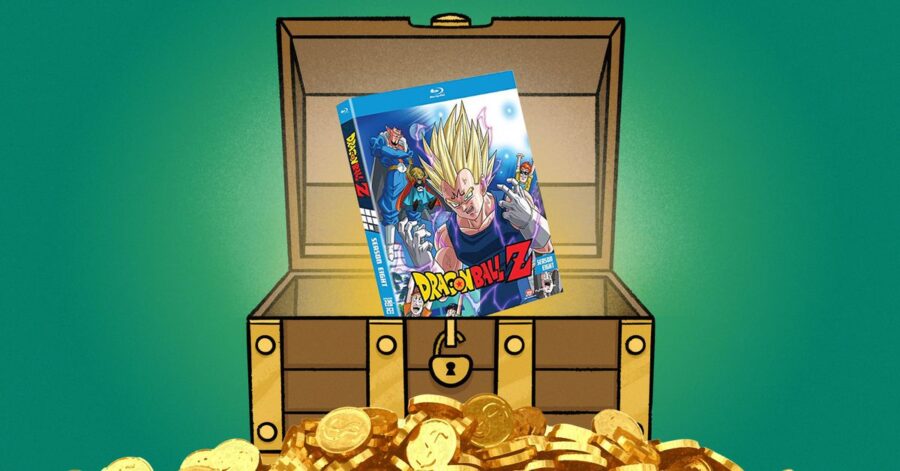With the wealth of options available at the press of a button, modern audiences are never more than three degrees removed from quality entertainment at their fingertips. Last week, to take a step back from it all, we published The Masterpieces of Streaming, a collection of essays, retrospectives, and curated recommendations of the very best film, TV series, and video available on platforms like Netflix, Hulu, Amazon Prime Video, YouTube, and more.
Of course, there are some things that streaming still can’t, or may never, be able to fully offer. The smell of a good book, the satisfying snap of a DVD case, the crackled hiss of a vinyl record spinning your favorite song. In an age of near-ubiquitous streaming, physical media remains a highly sought-after commodity that retains the potential of transcending that very commodification. The appeal of physical media isn’t just about the pride of owning the movies and television shows we love; it’s the experience of interacting with the objects themselves that makes these stories our own.
With that in mind, here are a few of Polygon staffers’ favorite pieces of physical media. Sound off in the comments and share some of your own.
Dragon Ball Z Blu-ray sets

Photo: Ryan Gilliam/Polygon
I’ve avoided physical media of any kind for years. In college, I didn’t have a lot of space in my dorm. I decided to start buying my games and media digitally, and I’ve never looked back. But one of the first things I purchased after graduation was the complete Blu-ray set for Dragon Ball Z. And I watched every episode in glorious, crummy HD.
Dragon Ball Z feels old to me. Partially because it is, but also because I remember watching it as it unfolded on Toonami. I sat there and watched one of the greatest cliffhangers of my young life — Super Buu turning Vegito into a toffee candy and devouring him whole — only for Cartoon Network to jump back hundreds of episodes (presumably because the show wasn’t finished). I sat, waited, and grew up waiting for that conclusion.
I’ll always have Dragon Ball Z on some kind of disc. I recently went so far as to purchase Kai on DVD as well. Part of this may be because various versions of Dragon Ball — especially Kai — are tough to come by on streaming platforms. But it feels right to me to hold the boxes in my hands and look down at the poorly framed stills on the back. This kind of access to the entire catalog of DBZ was all I ever wanted as a child: the ability to flip between sagas at my discretion, rather than Cartoon Network’s.
It’s the ultimate wish fulfillment from a very specific part of my life, and that alone makes it worthy of my limited shelf space. —Ryan Gilliam
Call of Duty: Ghosts, but make it ‘Happy Birthday Samit’
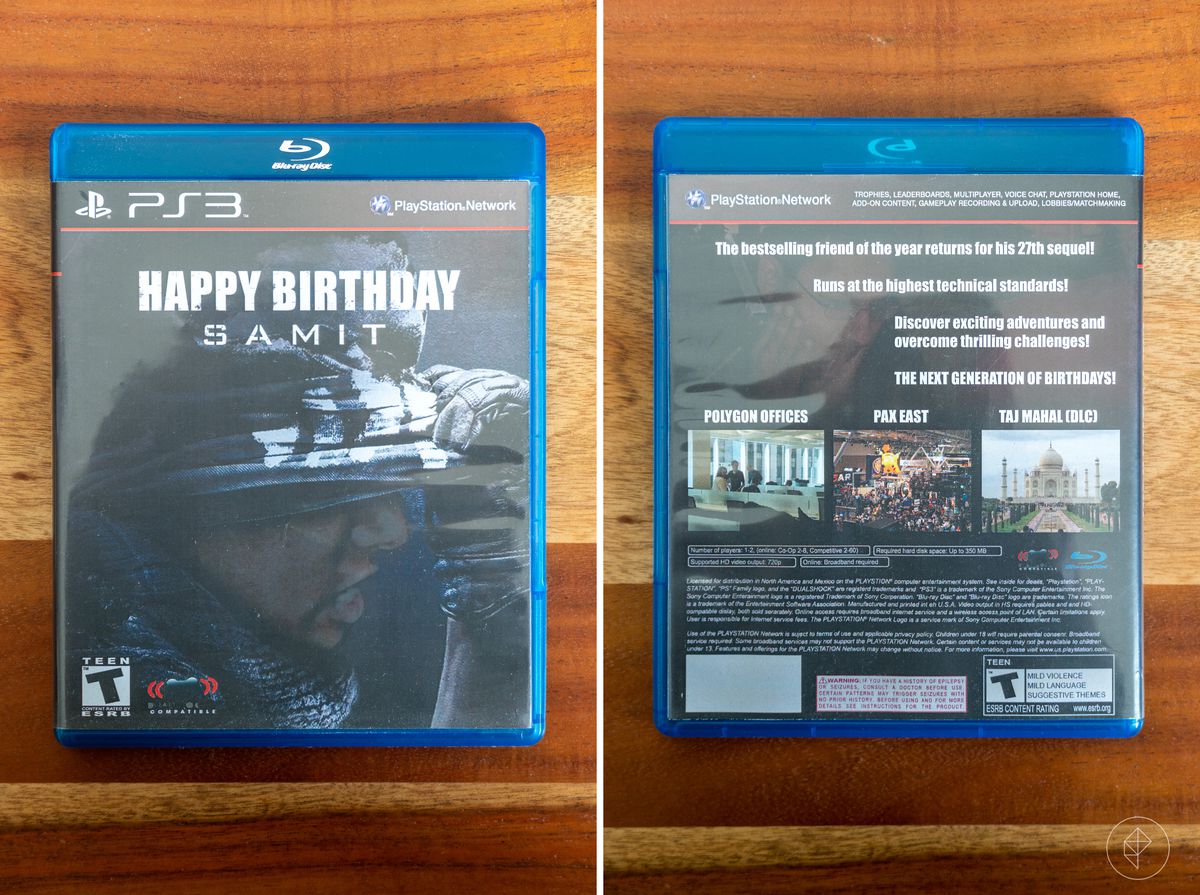
Photos: Samit Sarkar/Polygon
When it comes to life events that will force you to take stock of your stuff, moving is probably at the top of the list.
My wife and I have slowly been packing up our apartment for the better part of two months now, and one of the first things we boxed up was our sizable collection of films and TV shows, which comprises DVDs, Blu-rays, and 4K Blu-rays. We tackled this task early because it seemed simpler and less daunting than some others, and we were right. Naturally, we ended up getting rid of a bunch of stuff in the process — protip: most DVDs look like garbage on a 4K television — but one thing I will never part with isn’t a disc at all.
For my 27th birthday, my best friend, Joe, got me a gift card, which doesn’t sound all that impressive until you hear about the incredible packaging he designed for it. Joe took a Blu-ray case and created a custom insert for it — he’s a Photoshop wizard — modeled after the box art for that year’s Call of Duty game, Call of Duty: Ghosts. (I like Call of Duty just fine, but I assume the real reason he chose it was that the game came out right around my birthday.)
Instead of the title Call of Duty: Ghosts, the top of the box art says, “HAPPY BIRTHDAY SAMIT,” in the same font as the game’s logo. The game’s actual cover features a close-up of one of the titular clandestine soldiers lifting up a skull mask to reveal his nose and mouth — and Joe managed to Photoshop my own goddamn face into the image!
The back-of-the-box bullet points include phrases such as “The bestselling friend of the year returns for his 27th sequel!” and “THE NEXT GENERATION OF BIRTHDAYS,” the latter of which I find particularly funny because Joe used the PlayStation 3 box art for a game that was also launching on the (then-next-gen) PlayStation 4 and Xbox One.
Look … I’m nitpicking because, well, it’s in my nature. But really, every time I look at this thing, I’m bowled over and touched by how much effort Joe put into it. —Samit Sarkar
Batman Animated by Paul Dini and Chip Kidd
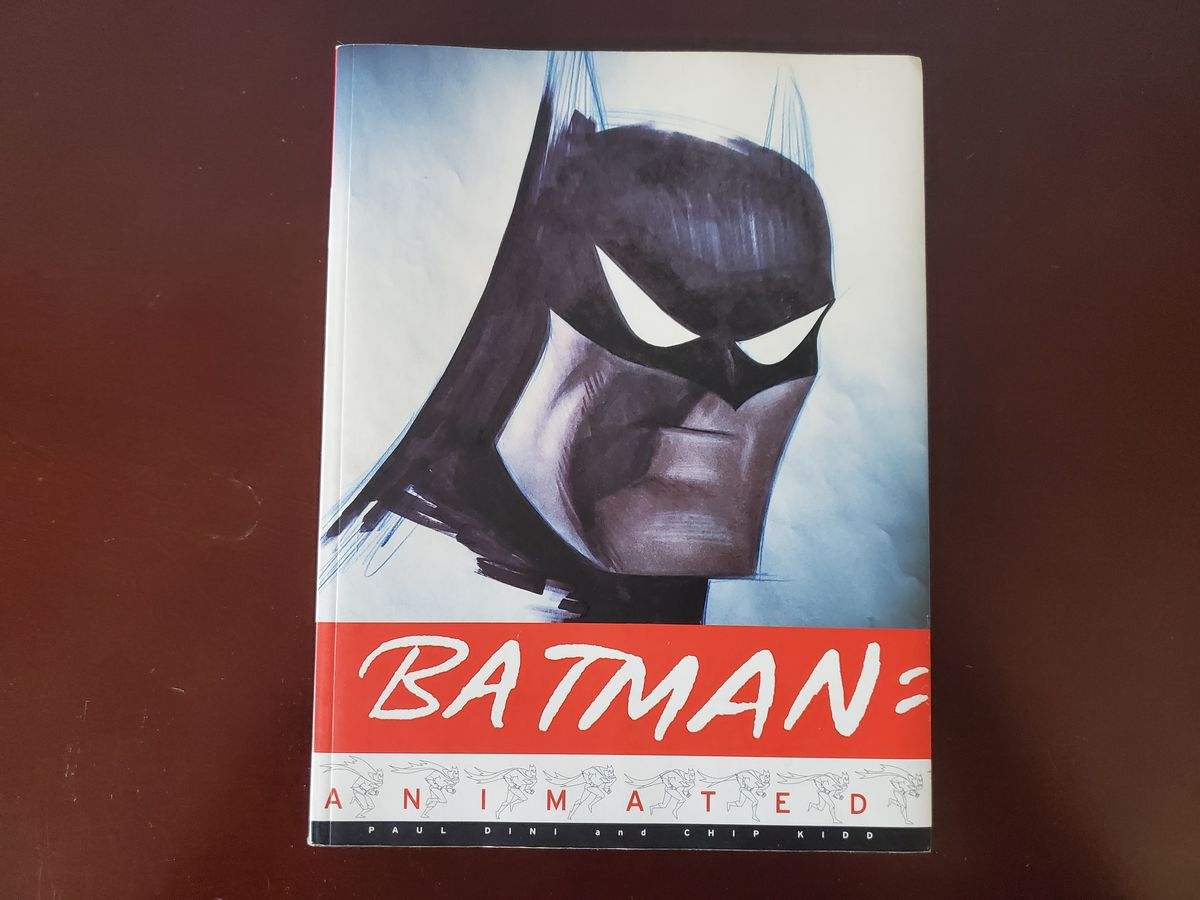
Photo: Toussaint Egan
I’ve been collecting art books ever since I was a teenager. Half-Life 2: Raising The Bar, Lead Poisoning: The Pencil Art of Geof Darrow, and The Complete Fables Covers by James Jean are a few of my favorites. But there’s one book in particular from my collection that I prize above all others and that represents something much larger to me: Paul Dini and Chip Kidd’s Batman Animated.
I’ve already waxed rhapsodic about how much Batman: The Animated Series means to me elsewhere on the internet. For me, the show wasn’t just a cool looking cartoon; it sparked a profound aesthetic reaction in me that set my imagination aflame and prompted questions that as a child I did not yet possess the knowledge nor even the words to adequately convey to others. Who made this show? How did they make this show? Why does it look the way that it does?
My fledgling love of the series represented the first time I became acutely cognizant of the fact that cartoons, or animation, did not just materialize from out of the ether, but rather were made by people — yes, actual people! Artists and designers and animators who came together to create a show that looked unlike any other children’s show at that time or before it, and yet whose visual identity remained unmistakably rooted in the precedent of the past. It was watching Batman: The Animated Series that set me on a lifelong personal journey to learn more about art and the artists who made it so that I could better understand and communicate what made that art so memorable and affecting and essential; a journey that has now since led to me writing about art as a career. Batman Animated contains nearly all the answers to the questions I was asking when I was kid, and I didn’t finally get my hands on the book until I was about 27.
To me, my copy of Batman Animated represents the end of a long and edifying journey and the beginning of yet another. —Toussaint Egan
The American 1965 Ballantine paperback editions of The Two Towers and The Return of the King
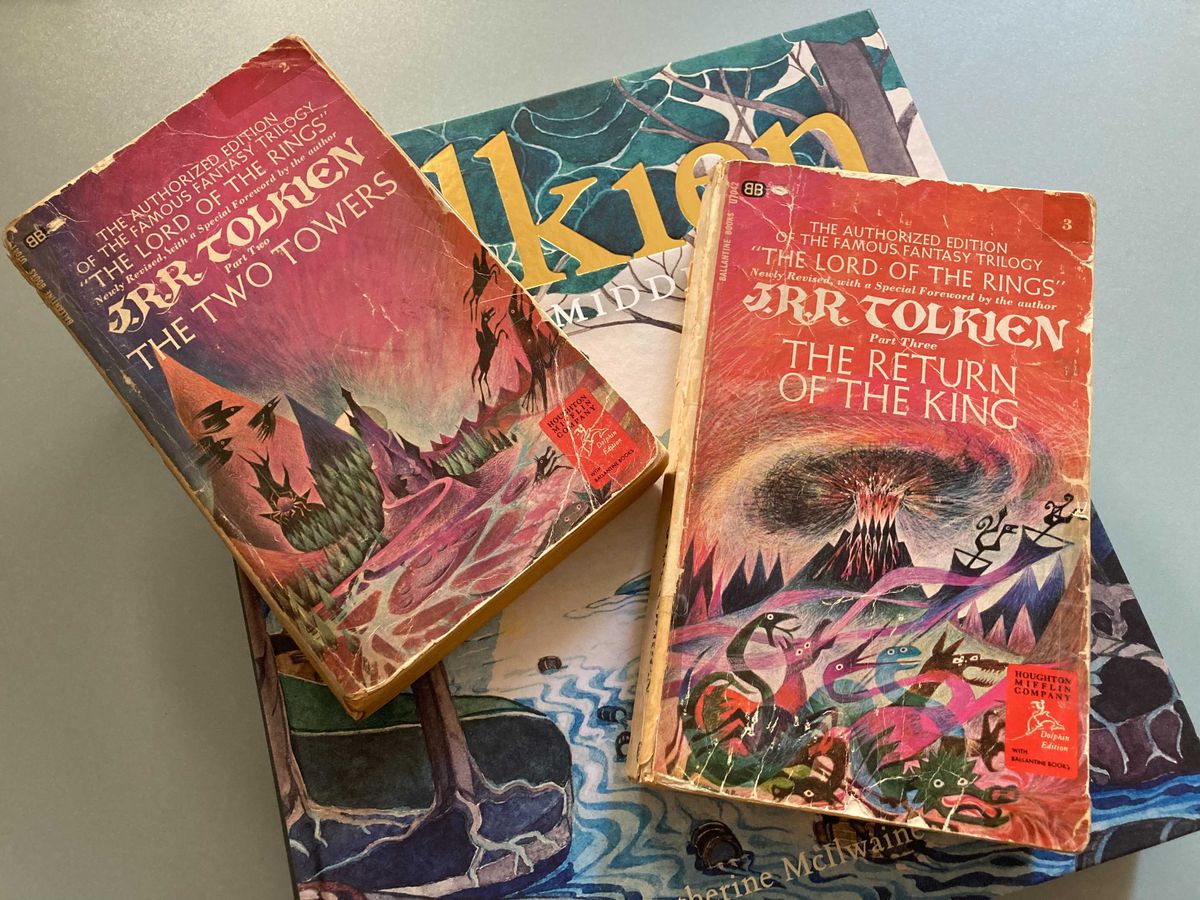
Photo: Susana Polo/Polygon
Copies of The Lord of the Rings come in all kinds of nice shapes and sizes these days, but not when I was in middle school. It’s safe to say that the “D&D manual but somehow worse” illustrations on my library’s shelves kept me away from Tolkien’s work for at least a year or two. The ones that finally stuck were fronted with enchantingly colorful landscapes teaming with armies of beastly silhouettes.
I kept my yellowing copies together with scotch tape and gentle handling for years before I found out the unique role they had in the story of the Lord of the Rings books. The secondhand copies my mom had nabbed at our local bookstore were part of the very first official American edition of The Lord of the Rings, rushed into production to crowd out thousands of unauthorized bootleg copies.
They were so rushed that Barbara Remington, who illustrated the paperback covers, was unable to find a copy before deadline, and had to make do on “sketchy information at best.” Tolkien, who even at his best was quite persnickety about the visual details on his books, detested her attempt. But I think it’s some of the best abstract fantasy art I’ve ever seen. The Two Towers and The Return of the King even depict Shelob, Mount Doom, and Black Riders!
My copies are falling apart so badly I bought another set to have some to read — someday I’ll get them rebound, and maybe even track down a matching Fellowship. They’re favorite objects for me personally, but also a piece of Lord of the Rings history. —Susana Polo
Vintage Star Wars soundtrack on vinyl

Photo: Charlie Hall/Polyon
When Star Wars came out in 1977, one of the first bits of merch to hit the street was the soundtrack. They produced this thing by the millions back in the day, but I didn’t find mine until the mid-1990s. That’s when my good friend John and I were perusing the stacks at Bizzy Bee CD Exchange in downtown Naperville, an old record shop in my hometown that was literally run out of some guy’s front room. I didn’t know a damn thing about music at the time, but I knew what I liked … and I liked Star Wars.
There were at least three or four copies of the soundtrack sitting there in the stacks. But, as years of perusing the bargain bins at Venture and Service Merchandise stores had taught me, you’ve gotta dig down to the bottom of the pile to find that good, good overlooked stuff. And that’s when I uncovered my treasure — the original liner notes, including annotations written by John Williams himself.
Looking back on it now, it’s fun to realize that this was likely fans’ first opportunity to hear about the making of the film from its creators. Among my favorite anecdotes is how Williams manipulated the sound of a Caribbean steel drum for the Cantina Band sequence. It’s the kind of raw, unfiltered account that only exists in a primary source like this. There’s lots of great albums in my collection today, but this one is by far my favorite. —Charlie Hall
Six copies of The Sun Also Rises by Ernest Hemingway
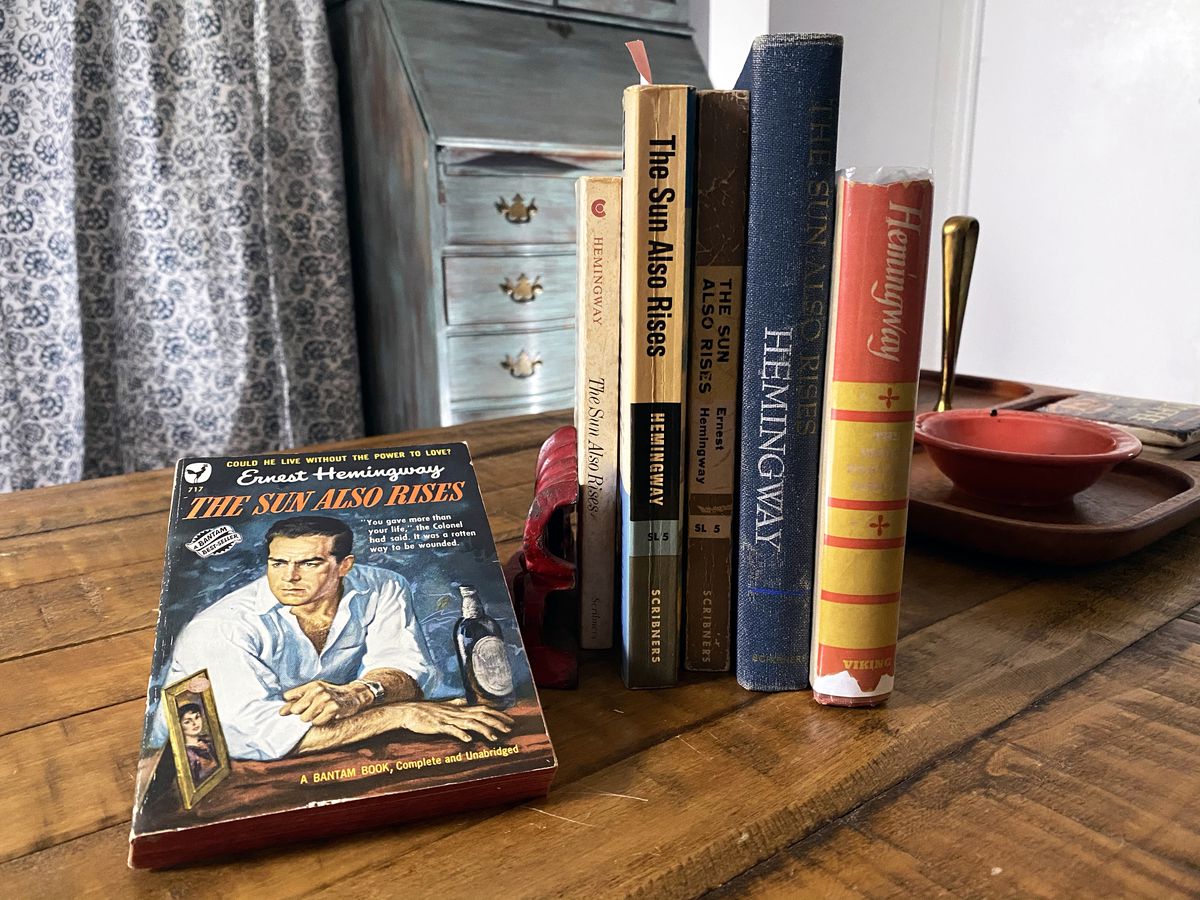
Photo: Simone de Rochefort/Polygon
I am not allowed to buy more books, with one exception. Whenever I go into a used bookstore, I head straight for the fiction section. I assume the Browsing Position — slightly hunched, head tilted sideways, hands clasped behind my back — and I strafe until I reach the letter H. I stop and brush my finger along each spine, looking for another copy of The Sun Also Rises.
There’s always some Hemingway in a used bookstore. Anecdotally, my most common find is the Hemingway Library Edition of The Sun Also Rises, a modern reprint of the original 1926 cover. A 2003 version with a blurry bullfighter and some truly hideous drop shadow on the title crops up a lot, too.
My favorite copies are all from the 20th century. I’ve got a blue hardcover that Scribner’s printed in 1954, and a 1970 edition with a beautiful painting of the Spanish countryside. The Scribner Library edition has a patterned gray cover and blocky title that I find weirdly appealing. It feels more true to the book than some of the newer illustrations. Karen Han found a ridiculous 1949 Bantam paperback on eBay and sent it to me. This cover shows Jake Barnes frowning deeply, next to a portrait of Lady Brett Ashley and a bottle of beer, I think? The text “COULD HE LIVE WITHOUT THE POWER TO LOVE?” is printed across the top. It is perfect.
It feels special when a beautiful book comes to you by chance. One day I was walking home from a flea market and passed a streetside bookseller on Columbus Avenue. A red and yellow cover caught my eye, and then the printed name: just Hemingway. I had found a 1944 Viking Portable Library edition that had all of Sun, and selections of his short stories, with an intro from Malcolm Cowley. I had never seen it before. It’s in near-perfect condition, and its pages are silky and thin. I didn’t look for it; it found me. —Simone de Rochefort
A24’s limited edition 4K Blu-ray of the Midsommar Director’s Cut

Photo: A24
The theatrical version of Ari Aster’s Midsommar is an ambitious horror movie that’s somewhere between pretty good and great. However, in the director’s cut, with its nearly 30 minutes of extra footage and very different edit, Aster’s Scandinavian-cult movie becomes something truly special. The tone smoothly floats between funny, absurd, and absolutely horrifying. The detestable boyfriend character becomes even worse, and the cult itself has the chance to grow into a more complete society and world, which makes for a much better ending and adds depth to Florence Pugh’s character that just doesn’t come across in the original cut. The Midsommar Director’s Cut makes it a truly one-of-a-kind horror movie.
Unfortunately, it’s really hard to see the director’s cut. Which is exactly why I love this 4K physical copy of the director’s cut sold by A24. The bright yellow packaging and ridiculous height look weirdly great next to standard Blu-rays, and it’s got a small art book of some of the movie-cult’s weirdest drawings. On top of that, it guarantees that I have a way to watch the best version of the movie, without relying on Apple Movies’ special features — which seems to be the only other way to see it. This physical edition of the Director’s Cut is still available on A24’s website, at least for now. —Austen Goslin
Old games on my Sony PVM-1910

Despite having a very large collection of video games, I am not particularly sentimental about any individual piece; instead, I care about the combined whole. With that in mind, I’m going to cheat a little and select something that helps me enjoy that collection: my 19-inch Sony Trinitron PVM. If you’re not familiar with the acronym, it stands for professional video monitor, and somewhere around five to 10 years ago, places would basically pay you to haul these analog relics away. I wasn’t that lucky, but I did manage to score this unit with a cut cord, and some power supply issues, for free. After finding someone who could actually repair it, and $100 later, I once again had a working CRT for the first time since 2006.
Originally built for broadcast or professional video editing markets, PVMs aren’t just any old tube TV. Thanks to their support for RGB inputs and razor-sharp pixels, scanlines and all, 240p signals not only work on this monitor with effectively zero input lag, but they look … correct. There’s something about the way that old games look on my high-definition set that feel clean and sharp but also off. Here, look at this delightful Twitter account for examples. Here’s a good one:
Super Mario RPG (1996, Square) – SNES
Sharp Pixels vs. SNES S-Video via Sony KV-27S42
Love the difference in Peach’s hair and dress here especially. pic.twitter.com/v1uUD5O3Pf
— CRT Pixels (@CRTpixels) June 2, 2024
When I sit down to play old games, it’s usually on the PVM. Now I worry about when this thing might die, since working CRTs are even harder to come by and … actually, let’s not think about it. Instead, I’ll fire up the Sega Genesis and play some Gunstar Heroes and everything will look, and feel, just right. —Chris Grant
The Adventures of Pete & Pete seasons 1 and 2
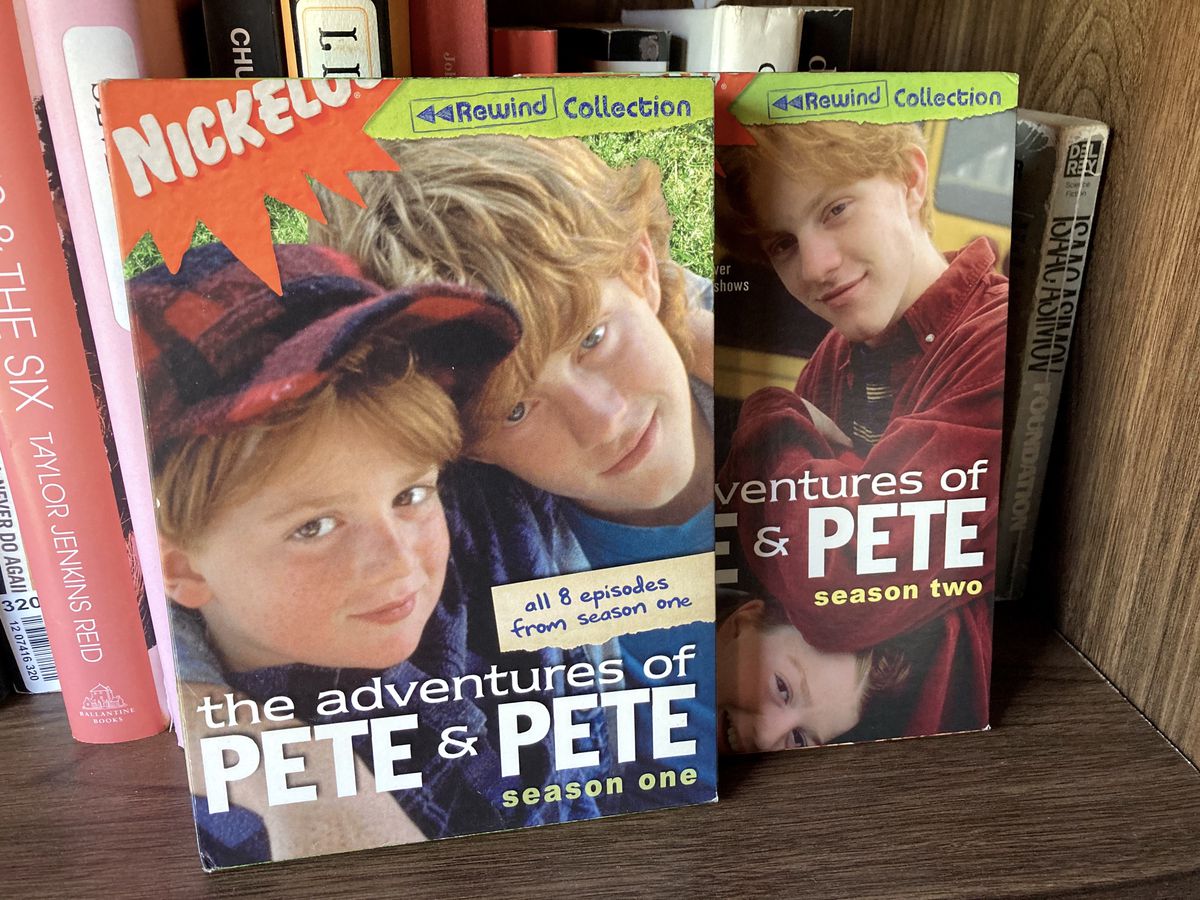
Photo: Matt Patches
I’m happy to lay down a few bucks for physical media that I want to put in my personal vault, but sometimes the actual hustle to obtain copies of a beloved show or movie can be its own headache. I would own all three seasons of Nickelodeon’s live-action comedy The Adventures of Pete & Pete, a sitcom that helped young weirdos make sense of the ups and downs of suburban reality, but only season 1 and 2 have ever been released. A season 3 set, it turns out, was printed but remains under lock and key due to escalating music costs. On top of being a show about hunting down mysterious ice cream men, breaking world records with the Strongest Man in the World, sticking chunks of cereal dangerously far up one’s nose, and traveling through time via the vortex of Daylight Saving Time, the series was also a crash course in alternative rock. On top of Polaris, who gave a musical soul to the series, the creators filled Pete & Pete with needle drops (and even got the likes of Iggy Pop and Debbie Harry to cameo on the show). But renegotiating deals with every band that appeared on the soundtracks proved too difficult, or at least not worth the time after the sales number from seasons 1 and 2, so Nickelodeon nixed the season 3 box set. So I can’t watch it. And that sucks.
But I’ll always have the first two, golden seasons. And I put the discs to good use, returning every now and then for a late-night spin with two disaffected, loving brothers who don’t fit all the well into the buttoned-up, corporate-friendly “normal” world. Thank god. —Matt Patches
Tarsem Singh’s The Fall
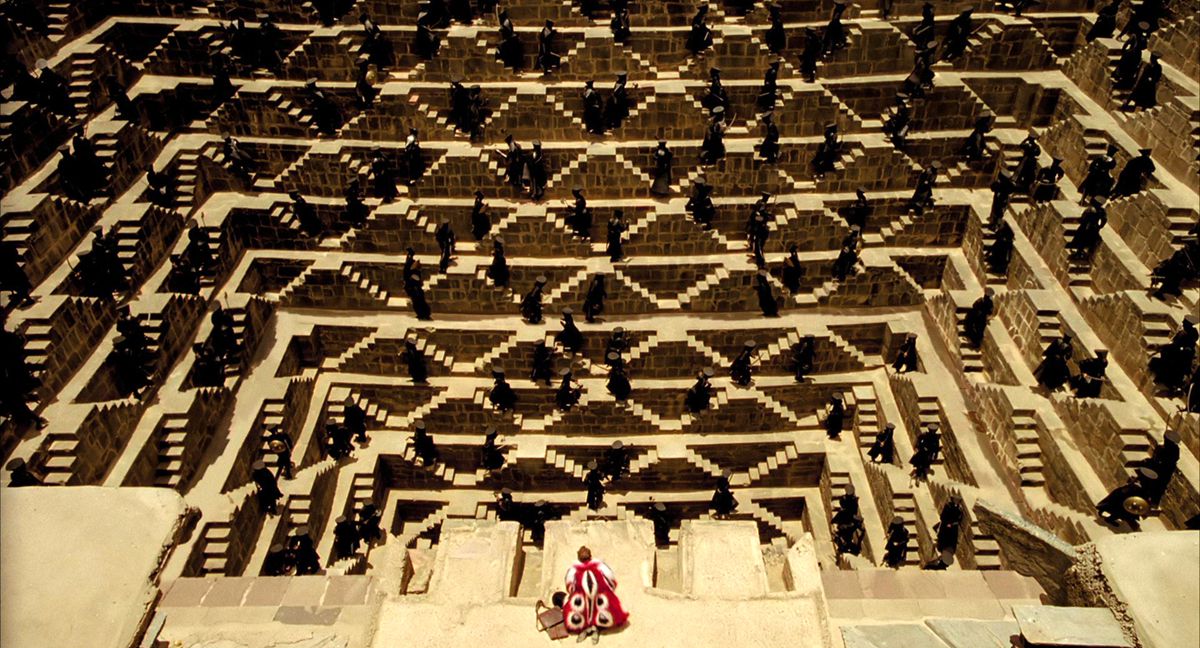
Photo: Sony Pictures Home Entertainment
Anyone who knows me in person has probably heard me rabbit on at least once about The Fall, Tarsem’s epic fantasy about the escapist value of storytelling, as seen through the eyes of a broken-hearted stuntman (Lee Pace) trying to take his own life, and the young child (Catinca Untaru) he recruits as his unwitting assistant. A lot of people who’ve never met me have also heard me go on about it, since I did an entire podcast episode about it with my former co-worker Keith Phipps and Daily Show writer / The Flop House host Elliott Kalan. It’s a longtime favorite, for so many reasons: the deeply strange plot, which jumps in and out of fairy-tale mode as Pace’s character tells Untaru’s a story to manipulate her. The stunning visuals, shot around the world in 24 countries while piggybacking on Tarsem’s commercial work. The ridiculous behind-the-scenes stories, which had Pace pretending to be a paraplegic for three months, while Untaru thought she was filming a documentary.
Above all, it just isn’t like anything else: Its grand, swoony emotions are meant in some ways to communicate the blinkered self-importance of Pace’s two characters, the one he plays in the real world, and the fantasy version of himself he invents to manipulate his child helper. Anyone who’s wallowed in self-pity after getting dumped or shot down — or dealt with a friend who’s doing the same — will recognize these feelings, but The Fall blows them up to stately, grandiloquent size, both to capture how they feel in the moment, and to laugh at them a little. It’s an extremely weird movie, which may be why it’s so unavailable, neither streaming online nor in print in physical form. My DVD copy of the film is nothing special — no meaningful extras, no special-edition bonuses — but it means I can let other people in on my obsession even in a world that doesn’t value this film as immensely as I do. —Tasha Robinson
Polygon – All
Source link
Related Post:
- In Japan, Demon Slayer Just Sold Over A Million Blu-Rays And DVDs In Three Days
- Top 10 biggest Netflix movies and shows right now (June 22 2024)
- Mortal Kombat 11 has now sold 12 million copies and Mortal Kombat series has sold 73 million copies in total
- In Rays Of The Light (Xbox Series X|S) Is Now Available For Digital Pre-order And Pre-download On Xbox Series X|S
- In Rays Of The Light (Xbox Series X|S) Is Now Available
- In the Heights and 11 big new movies you can watch on Netflix, HBO, and Amazon
- Luca, Fatherhood, and 9 new movies you can watch on Netflix, HBO, and Amazon
- Demon Slayer and 11 new movies you can watch on Netflix, HBO, and Amazon
- Black Widow and 6 new movies you can watch on Netflix, Apple, and Amazon
- Space Jam 2 and 9 new movies you can now watch on Netflix, HBO, and Amazon
